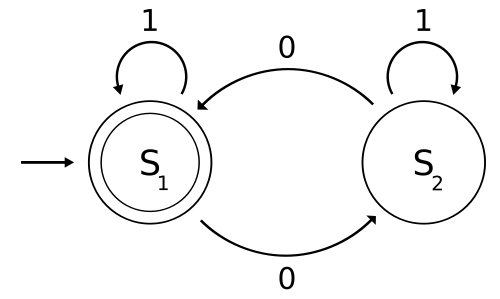State diagram
State diagrams are used to graphically represent finite state machines. State transition tables are another possible representation.
There are many forms of state diagrams that differ slightly and have different semantics.
Directed graph
A classic form of a state diagram for a finite state machine is a directed graph with the following elements:
States Q: a finite set of vertices normally represented by circles and labelled with unique designator symbols or words written inside them (Booth (1967) p. 69, Hopcroft and Ullman (1979) p. 16, Sipser (2006) p. 34).
Input symbols Σ: a finite collection of input "symbols" or designators Σ (Booth, Hopcroft and Ullman, Sipser). For a deterministic finite state machine (DFA), nondeterministic finite state machine (NFA), generalized nondeterministic finite state machine (GNFA), or Moore machine, input is signified on each edge, usually near the originating state. For a Mealy machine, input and output are signified on each edge usually shown separated with a slash "/":
- Mealy input and output labels on an edge (arrow): "1/0" designates symbol "1" caused symbol "0" as output.
Output symbols Z: a finite collection of output "symbols" or designators (Booth, Hopcroft and Ullman, Sipser). For a Mealy machine, input and output are signified on each edge as shown above. For a Moore machine the state's output is usually written inside the state's circle, separated from the state's designator with a slash "/".
- Example: If a state has a number of outputs (e.g. "a= motor counter-clockwise=1, b= caution light inactive=0") the diagram should reflect this : e.g. "q5/1,0" designates state q5 with outputs a=1, b=0. This designator will be written inside the state's circle.
The "Output function ω" represents the mapping ω of input symbols Σ × states Q into output symbols Z (Booth).
Edges δ: represent the "transitions" between two states as caused by the input (identified by their symbols drawn on the "edges"). An 'edge' is usually drawn as an arrow directed from the present-state toward the next-state. δ represents the mapping of input symbols Σ × states Q onto output symbols Z (Booth, Hopcroft and Ullman, Sipser).
Start state qo: (not shown in the examples below). The start state qo is usually represented by an "arrow pointing at it from nowhere" (cf Sipser (2006) p. 34, Hopcroft and Ullman (1979) p. 16). In older texts (e.g. Booth (1969), McCluskey (1965), Hill and Peterson (1974)) the start state is not shown and must be inferred from the text.
Accepting state(s) F: If used -- a collection of double circles used to designate accept states (Hopcroft and Ullman, Sipser). Sometimes the accept state(s) function as "Final" (halt, trapped) states (cf Hopcroft and Ullman (1979) Figure 2.15, p. 33).
Examples:
DFA, NFA, GNFA, or Moore machine
S1 and S2 are states and S1 is an accept state. Each edge is labeled with the input.
Mealy machine
S0, S1, and S2 are states. Each edge is labeled with "j / k" where j is the input and k is the output.
Harel statechart
Harel statecharts (developed in 1987 by David Harel) are gaining some more widespread usage since a variant has become part of UML. The diagram type allows to model superstates, concurrent state diagrams and e.g. to model activities as part of a state.
Classic state diagrams are so called "or" diagrams, because the machine can only be in one state or the other. With Harel statecharts it is possible to model "and" machines, where a machine is in two or more states at the same time. This is due in part to the modelling of superstates and in part to the modelling of concurrent machines.
UML state diagram
The Unified Modeling Language (UML) (or SysML) state diagram is essentially a Harel statechart with standardized notation that can describe a lot of things, from computer programs to business processes. The following are the basic notational elements that can be used to make up a diagram:
- Filled circle, pointing to the initial state
- Hollow circle containing a smaller filled circle, indicating the final state (if any)
- Rounded Rectangle, denoting a state. Top of the rectangle contains a name of the state. Can contain a horizontal line in the middle, below which the activities that are done in that state are indicated
- Arrow, denoting transition. The name of the event (if any) causing this transition labels the arrow body. A guard expression may be added, enclosed in brackets( [] ) denoting that this expression must be true for the transition to take place. If an action is performed during this transition, it is added to the label following a "/". eventName[guardExpression]/action
- Thick horizontal line with either x>1 lines entering and 1 line leaving or 1 line entering and x>1 lines leaving. These denote join/fork, respectively.


